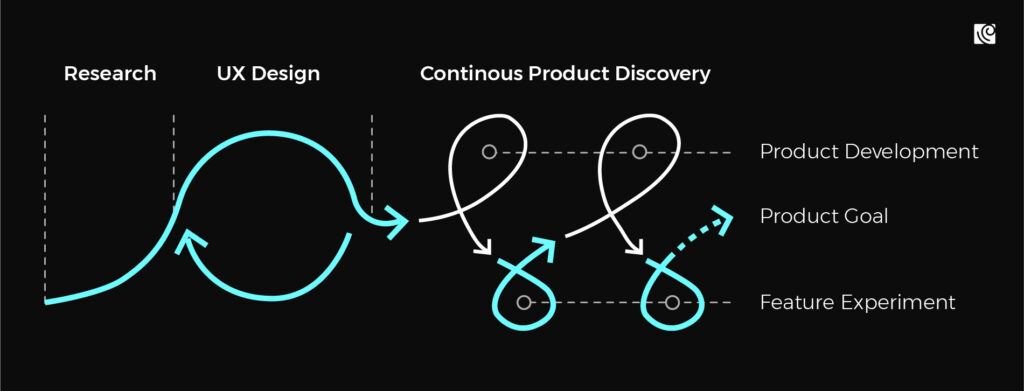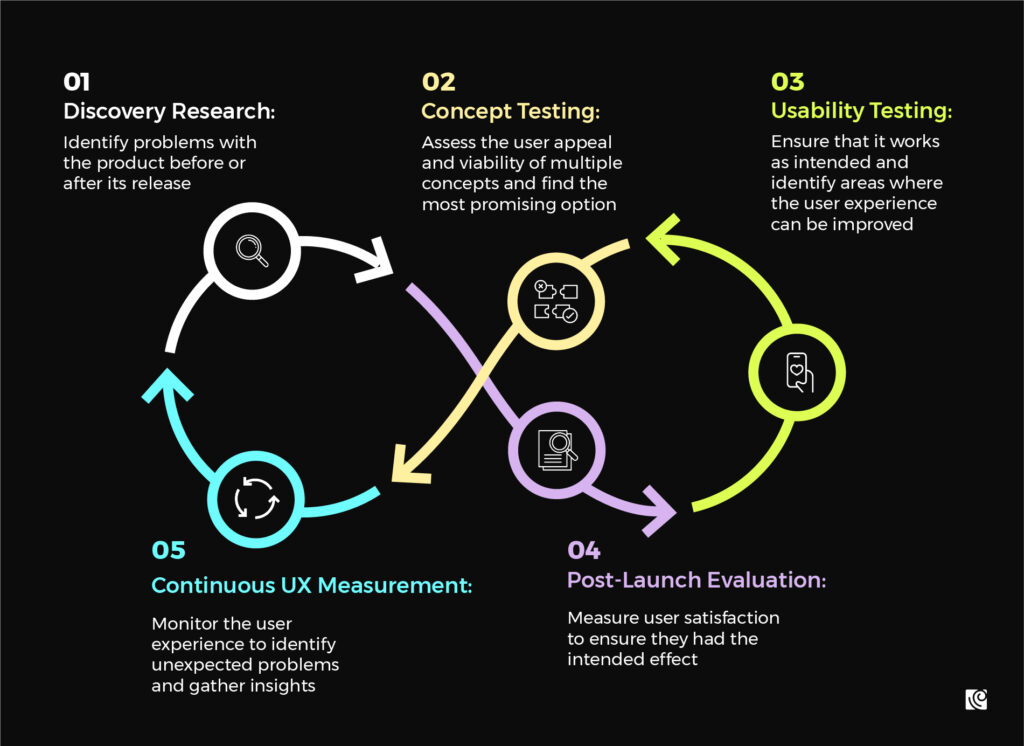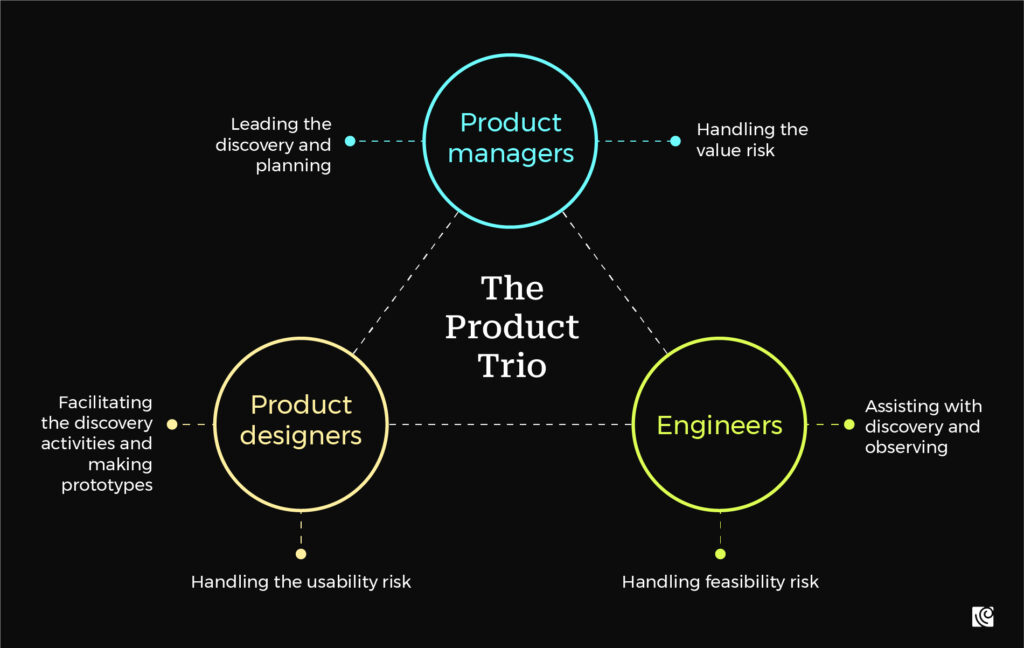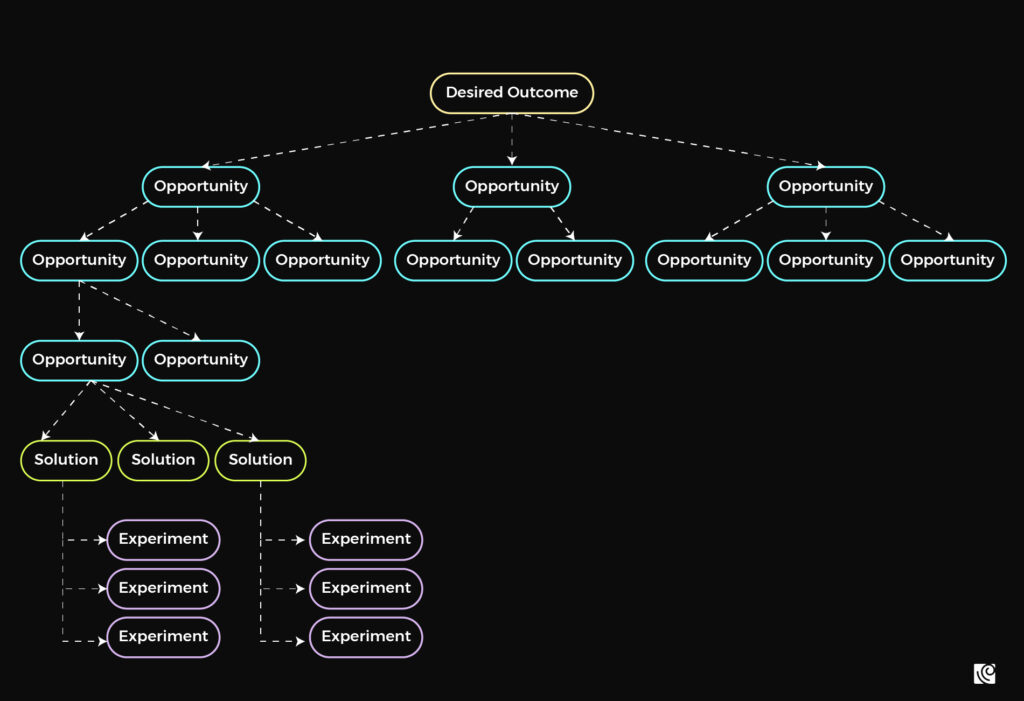Many product leaders think they’ve got product discovery covered— they integrate the discovery process at the start of the product design process, interview customers, and run usability tests, done.
However, the reality is a bit different.
Most businesses only conduct discovery activities sporadically and use the results to validate their existing decisions instead of informing new ones.
This approach is unproductive, as ad-hoc product design techniques only rely on a solitary research phase at the start of the process.
Besides, it can be costly. When discovery activities are not integrated throughout the product development cycle, businesses risk investing significant resources in building a product that may not meet customer needs or address their pain points. This can result in wasted time, effort, and money.
To truly embrace research and discovery, you need to prioritize ongoing research and testing to inform product decisions at every stage of development.
Everything in your product backlog is a bet, whether you do discovery or not. Discovery helps you make a better bet. There’s a time in business when it makes sense to make a risky bet. But that doesn’t mean you give up on making bets until you discover. Don’t do that. Keep making bets. In parallel, start doing some discovery continuously, so eventually, those bets get better.
Terresa Torres, Author of Continuous Discovery Habits
In this blog, we’ll talk about how continuous product discovery can help you with product cost optimization and most importantly, how to do it right!
What Does Continuous Product Discovery Mean?

Marty Cagan, an influential name in product management defines continuous product discovery as:
The process where you are constantly identifying, validating, and describing new product backlog items.
By continually testing and validating through authentic research, teams can ensure they are building a product that meets user needs and aligns with business goals.
Continuous product discovery also enables greater flexibility and agility, as teams can respond quickly to new insights and feedback from users. This can result in more successful product launches. Here are five stages of continuous product discovery.

The Cost-Saving Benefits of Continuous Product Discovery
A continuous discovery approach that involves ongoing research and testing helps businesses make informed decisions, reducing the risk of investing resources in a product that may not succeed in the market.
Ultimately, integrating discovery activities throughout the product development cycle can help businesses save costs by identifying potential issues early on and ensuring that their product meets customer needs.
Besides, this approach is more efficient. It allows teams to make adjustments and improvements as they go rather than waiting until the end of the development cycle to make changes.
It lets you take Control and Mitigate Risks While Innovating
Just two months back, Atlassian announced the release of three new enhancements for their Jira platform, which aims to democratize continuous product discovery. The goal is to enable product managers to align business and technical teams on ideas before development begins.
The new continuous discovery capability is the most significant part of the release. Teams can use Jira Product Discovery from idea to goal, including prioritization frameworks. Once the team knows what they want to build, they can move to Jira Software for the delivery phase.
Diego Lo Giudice, VP, and principal analyst at Forrester Research
Continuous product discovery allows for a more controlled approach to risk mitigation rather than just reacting to a crisis scenario. And preventing these risks is directly related to cost savings.
This approach focuses on rethinking and rebuilding rather than simply repairing.
So, why would one want to undergo such a dynamic product design and development process?
Incorporating continuous product discovery as part of the everyday product lifecycle helps you address three major product risks:

Value Risk
It refers to the possibility that a product or feature may not provide sufficient value to users, resulting in low adoption rates and revenue.
Continuous product discovery helps address this risk by involving customers in the product development process and gathering feedback on new ideas and features before investing significant time and resources.
Usability Risk
It refers to the possibility that a product or feature may not be intuitive or user-friendly, leading to frustration and poor user experience.
Continuous product discovery enables you to address this risk by regularly testing prototypes with users and gathering feedback on usability, allowing companies to make iterative improvements and optimize the user experience.
Feasibility Risk
It is the possibility that a product or feature may not be technically feasible to develop or implement within the desired timeline or budget.
You can address this risk by assessing new ideas and their feasibility early in the development process, allowing companies to adjust their plans or pivot if necessary.
Tips For Successful Continuous Product Discovery
Assemble Your Discovery Trio
Teresa Torres recommends creating a cross-functional team, consisting of a product manager, an experience/product designer, and a software engineer, to overcome the challenge of aligning teams with different assumptions and knowledge.

This team, also known as the “product trio,” should prioritize collaboration over their individual roles and engage in continuous product discovery to develop a shared understanding of customer needs and pain points. This way organizations can:
- Minimize the risk of investing in features or products that don’t meet user needs
- Reduce the cost of rework.
- Avoiding expensive mistakes based on assumptions and outdated knowledge
- Increasing the likelihood of successful product launches.
It also allows organizations to identify new opportunities and iterate on existing products more quickly, reducing the time and cost required to develop new features and products.
Incorporate Experimentation And User Discovery Into Your Product Roadmap
From the outset, make sure to allocate time in your product roadmap and calendar for experimentation and user discovery.
It’s essential to establish clear expectations with the product team that user needs are the top priority. This requires being open to rethinking and revising ideas, as well as relinquishing product ideas and timeframes when necessary.
In addition, gaining stakeholder buy-in for experimentation and new priorities is crucial. Using data-driven insights, demonstrate how changes in priorities can create more value based on your discoveries.
By doing so, you can make a clear case for why these changes are necessary and help ensure that experimentation and continuous product discovery remain central to the product development process.
Use The Double Diamond Approach
The Double Diamond process is often associated with product design.
When used specifically for continuous product discovery, the Double Diamond process may be called the Triple Diamond process, with two diamonds for discovery and one for delivery.

The process can be broken down into two main phases: problem discovery and solution discovery.
- Problem discovery involves identifying the initial problem or challenge and ends with a validated problem.
- Solution discovery involves finding an optimal first version of a solution to be delivered.
To conduct successful continuous product discovery, teams should engage in both primary and secondary research activities, such as:
- User interviews
- Surveys
- Ethnography
- Competitor analysis
On top of that, teams should focus on iterative activities like wireframing, storyboarding, prototyping, and user story mapping to develop and validate solutions.
Map Everything: Visualize Your Thinking Through Opportunity Solution Trees
An opportunity solution tree is a visual tool used in continuous product discovery to help teams organize and prioritize their ideas and solutions.
This can help with product cost optimization by ensuring that solutions are addressing the root cause of user pain points, rather than simply treating symptoms.
It begins with a desired outcome, typically a customer problem or pain point that needs to be addressed, at the root of the tree. From there, the team branches out into opportunities and potential solutions that come out of their customer interviews.

Here’s how you go about it.
Step 1: Identify the desired outcome of the product or feature you are working on.
This could be something like “reduce the administrative burden on healthcare providers.”
Step 2: The team conducts research to identify opportunities that can help achieve this goal.
Opportunities are potential areas for improvement or innovation that can help address the desired outcome. For example, an opportunity in the above scenario might be “create a seamless integration between the telehealth platform and the EHR to reduce the time and effort required for providers to document telehealth visits.”
Step 3: The team generates potential solutions for each opportunity.
This is where ideation comes into play. Brainstorming sessions and other ideation techniques are used to come up with a variety of potential solutions for each opportunity.
In this scenario, the potential solutions for the above-mentioned opportunity can be:
- Simplifying documentation between appointments
- Including pre-appointment responses from the patient to help providers prep in advance
- Trigger follow-up steps post-consultation
Step 4: Evaluate and prioritize
Once all potential solutions have been generated, the team can evaluate and prioritize them based on a variety of factors such as feasibility, impact, and user desirability.
This can help narrow down the list of potential solutions to a few key ideas that can be further developed and tested.
Read how we devised a coherent solution for the above scenario by constant iteration and prioritizing:
A Co-Creation Mindset
Teams can move faster by regularly performing small discovery activities to gain more insights about their users. This habit can benefit not only small businesses but also larger enterprises that lack dedicated continuous product discovery resources.
Teresa Torres emphasizes leaving behind the validation mindset and rather adopting a co-creation mindset:
“Rather than just validating a solution to a user’s problem, teams should engage with users early and often to develop a relationship where users feel comfortable giving feedback.”
To get started, teams can focus on activities such as:
- Reaching out to potential and current customers each week
- Iterating prototypes based on user feedback
- Testing one discovery experiment every week.
By committing to being customer-centric and engaging with users regularly, teams can gather valuable feedback and make iterative improvements to their products.
To Conclude…
Adopting a continuous product discovery model can have a significant impact on your company’s bottom line.
But the best way to understand its benefits is by applying its principles and validating the approach for yourself. This change does not require dismantling your existing discovery structure, but rather empowering employees to be more involved in daily processes.
It involves creating smaller, more agile project teams that focus on specific product goals and use design methods that can quickly assess experiment results.
The key is to adapt to a new process, eliminate communication barriers, and reduce bureaucratic obstacles to unlock the full potential of your design teams, allowing for quick decision-making and implementation across multiple product development areas.










